N. D. Desai—Industrialist with a Mission
A successful Bombay engineer seeks to inspire purity
in his daily world of business and finance
by Yogesvara dasa
Every evening at 6:00 Narendra Desai leaves his office in downtown Bombay. His chauffeur drives him home through Streets crowded with cars, trucks, ox-carts, rickshas, eight million people, and an occasional elephant. They pull up at a seven-story building overlooking parks, swimming pools, and the Arabian Sea. Upstairs, Dr. Desai bathes, changes into white silk robes, applies two lines of sacred clay to his forehead, and enters the marble temple in his apartment. He places three drops of water in his right hand, then three drops in the left, lights three sticks of incense, and begins reciting Sanskrit verses of prayer.
Soon his wife and three children join him. Tiny burning wicks of clarified butter throw soft light on the devotional paintings and tapestries. Everyone’s attention is focused on the smiling Deities of Lord Krsna and His consort Radha. After the last prayer has been recited and the last flower offered, parents and children bow to the floor in submission to the Deities and then prepare for a dinner of vegetarian dishes first offered to the Lord.
The Desai family repeats the procedure each morning and evening, seven days a week, 365 a year. Brought up by pious, well-to-do parents, Dr. Desai has known the significance of the arati ceremony since childhood. In fact, so have most Hindus. The same elaborate offering to the Deity takes place in millions of homes across the subcontinent and around the world. Krsna, the ceremony proclaims, is the Supreme Lord and enjoyer of all works and sacrifices. He is the real master of the home, and His pleasure is the true goal of one’s daily activities.
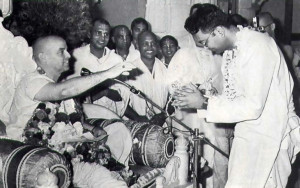
For Dr. Desai, however, the ceremony does not end with the last ablution. As an initiated devotee of ISKCON, the International Society for Krishna Consciousness, he has dedicated his words, wealth, intelligence, and life to spreading the teachings of Lord Krsna. His spiritual name, Nathji dasa, means “servant of Lord Krsna, who is the master of all creation.”
An ordinary day for Nathji begins at 4:00 A.M. After morning duties he takes a brisk walk around Seaface Park while chanting Hare Krsna on prayer beads and then joins his family in their temple room by 6:30 for ceremonies and a reading from Bhagavad-gita. At breakfast, father and children trade stories from the epic histories Ramayana and Mahabharata. At 8:00 Nathji brings his children to school and continues on to his office, where duties may include reviewing company accounts, evaluating new equipment, calling the minister of finance in Delhi about a new export factory, or visiting the refinery in Trombay, a Bombay suburb. Nathji returns home by 7:00 for evening temple ceremonies, an offering of foods to the Deity, and then dinner with his family. Before retiring at 10:00 he may read from scriptures or prepare notes for his Sunday lecture at ISKCON’s Bombay temple and cultural center.
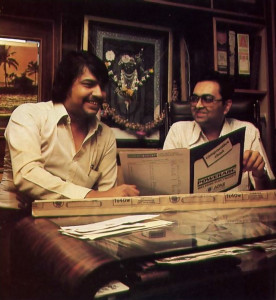
Nathji is the chairman of the board and managing director of several private companies, whose total combined sales exceed $40 million annually. Among his factories are India’s largest producer of light bulbs, fluorescent tubes, and other lighting supplies and the country’s second largest supplier of active electronic components. Despite the importance of his various enterprises, Nathji’s real attention remains focused on his projects for spreading Krsna consciousness. In addition to providing financial backing for temples, cow protection centers (go-salas) like the one at the ISKCON asrama in Hyderabad, and the printing of Vaisnava literature, he has designed a traveling temple, built on a large Tata company truck chassis that will broadcast Bhagavad-gita to villages all over India. He sponsors gatherings as well—sometimes in tents holding fifteen thousand people, sometimes in the privacy of his own apartment—to teach bhakti (devotional service to Lord Krsna) and encourage membership in ISKCON. Nathji also serves as General Secretary to Bombay’s Bhaktivedanta Institute, a branch of ISKCON dedicated to presenting Vedic scriptural conclusions in scientific terms.

At age twenty-one Nathji graduated with a masters’ in engineering from the University of Pennsylvania. That same year he secured a contract from Sunoco to open a nonfuel oil refinery outside Bombay. and soon thereafter he finished his Ph.D. One evening in 1971 he met devotees for the first time at his parents’ house. His father, a member of Indian Parliament and president of several Bombay factories, often received religious people at his home. He greatly appreciated Srila Prabhupada’s purity and world preaching efforts and invited him to come with disciples for chanting and a lecture. That evening Nathji’s father became one of ISKCON’s first Life Members, but Nathji remained skeptical. He had read several editions of Bhagavad-gita commented upon by impersonalistic scholars, and the nondevotional, monistic school appealed to him more than the idea of a personal God.

Still, Nathji began to visit Srila Prabhupada whenever Prabhupada came to Bombay. “I would argue that the Vedas describe every living entity as brahman, spiritual energy, and that Krsna is just one expression of that spiritual energy. Srila Prabhupada would correct me immediately. ‘You may be brahman, but Krsna is the Supreme Brahman. He is the source of everything, including the brahman energy. You are a tiny particle of brahman, and He is the complete whole. Where have you picked up this nonsense impersonalistic idea? You are God? Did you create the universe? What is your authority to speak? Krsna spoke Bhagavad-gita. Can you speak such wisdom?’ In this way he would defeat me.”
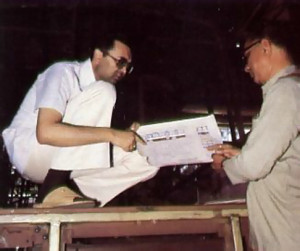
Despite philosophical differences with Srila Prabhupada, Nathji was attracted by his explanations and broad vision of theological matters. Studying the books of Krsna consciousness and attending classes at the Bombay temple led Nathji to adopt the chanting of Hare Krsna as a daily meditation. Eventually he even relinquished his impersonal conceptions of truth in favor of the Vaisnava explanation that the soul retains individuality eternally in loving service to the Supreme Person.
Just when Narendra Desai was feeling ready to take initiation into Krsna consciousness, Srila Prabhupada left this material world. Dr. Desai approached Giriraja Swami, the president of ISKCON Bombay, and asked where he was to find a bona fide spiritual master now that Srila Prabhupada was gone. Giriraja Swami handed him some cassette recordings of Srila Kirtanananda Swami, one of the disciples Srila Prabhupada had entrusted with the duty of initiating new devotees. Nathji listened and found Kirtanananda Swami’s explanations nondifferent from those of Srila Prabhupada. Each point was clearly and authoritatively presented.
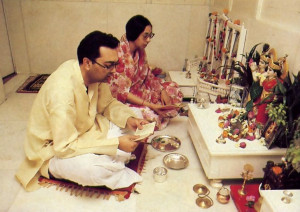
“That was when I knew I had found my guru. Just as the Ganges water is the same at Devaprayag, Hrsikesa, and Hardwar, so the teachings coming down in disciplic succession from Lord Krsna are the same, whether delivered by Srila Prabhupada or his faithful representative. I know that by hearing from Srila Kirtanananda Swami I receive the same wisdom passed down through the entire history of Vaisnava spiritual masters.
Relatives and acquaintances looked askance at the idea of a highborn Hindu taking initiation from an American. “I told them there was nothing American left in him, that he had completely dedicated himself to Krsna’s transcendental loving service. But many of them remained socially offended. I had been in Bombay five years, accumulating ‘friends’ like sins, and after my initiation many of them at first shunned me.”
The notion that only born Hindus can accept spiritual initiation or perform the initiatory rites is widespread in India yet erroneous. According to Vaisnava scriptures, offering initiation into spiritual life is the prerogative of anyone fully conversant with the science of Krsna consciousness, and any sincere person can be a candidate for initiation. Nonetheless, social custom has made guruship and discipleship the privileges of those born in brahmana, or high-caste, families. Sri Caitanya Mahaprabhu, who promulgated the Krsna consciousness movement in Bengal five hundred years ago. defied this artificial restriction and, on the authority of scripture, accepted disciples from middle-class, low-class, and even outcaste families. The spiritual masters in succession from Him have followed His example.
Nathji was not disturbed by the criticism (“I didn’t become a devotee to win friends,” he says), and he continued his devotional practices openly. Paintings of Lord Krsna and His many incarnations adorned the walls of his office and home. Holiday gifts to clients included posters of the Deities at New Vrindaban, his spiritual master’s rural community in West Virginia. Many photos of Srila Prabhupada and Kirtanananda Swami graced the tops of his desks, tables, and dressers. Nathji even printed a special pocket edition of Bhagavad-gita, just to have on hand for visitors and friends.
Not long after Nathji’s initiation, a young Communist union leader instigated a strike at one of Nathji’s factories. Nathji rejected the strike leader’s ambitious demands and instead handed him a copy of Srila Prabhupada’s Bhagavad-gita.
“This has nothing to do with religion,” the union organizer said. “We are talking worker-management relations.”
“Then consult the real owner of the factory,” Nathji replied. “My workers know I am a devotee of Lord Krsna. They know I manage this place on His behalf. They also know I try to encourage them by setting an example of fairness and concern for their well-being. These are qualities Lord Krsna praises in the Gita. But your demands are unreasonable by any standards except your own. If you want to negotiate successfully with me, I suggest you take this book home and read it.”
Nathji noted that the workers were impressed by hearing him speak so strongly about the Gita’s teachings, and after a few meetings they signed an agreement. Nathji later learned that the union leader, like many of his contemporaries, had received training in Bhagavad-gita as a boy and that the negotiations had rekindled his appreciation for its teachings. After the strike the union leader even commented that work, after all, “wasn’t everything.” Eventually he quit the Party and took to regularly studying the sacred text.
“I had never heard of a strike being argued in quite that way,” Nathji says, “but one must have the strength of his convictions. Especially in business, where corruption is so widespread, Bhagavad-gita has been for me an important guiding force for knowing how to act in the right way.”
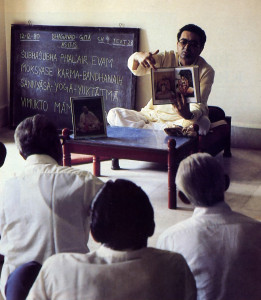
Acting “in the right way” is a lesson Nathji imparts gently to his children, whom he feels have been “entrusted” to him. “Lord Krsna describes in the Gita that unsuccessful yogis take their birth in affluent or devotee families, a position from which they may easily complete their course of self-realization. By Krsna’s arrangement, I am able to offer my children a favorable situation for becoming Krsna conscious, and I therefore take it that they are very elevated souls.
“When I talk to them about the eternality of the soul and our loving relationship with Krsna, they take it seriously. It’s not that I impose the Gita’s teachings on them; they actually understand and follow. Of course I still play the role of father, but they know that in a higher sense Krsna is their real Father and I am more like a guardian.”
Nathji also teaches his children not to fall for what he calls “sweet talk, “—that is, the allurement of materialism—without carefully considering the consequences. “A classmate may invite them to smoke or drink or indulge in some other distraction, so we have an agreement. Before accepting any proposal they are not sure is truly beneficial, we discuss: What do the scriptures say? What will the effect be? What is the authority behind the suggestion, its motive? Naturally, the main thing is for them to see good examples in their father and mother. Children are so perceptive, they see even the slightest flaw. In that way they are forcing us to become Krsna conscious.”
Nathji’s mother, an elderly woman who has done much social service and received several requests to run for public office, was at first suspicious that such a large organization as ISKCON might have been infiltrated by the C.I.A. Her suspicions were allayed when Giriraja Swami reassured her that any agent capable of chanting Hare Krsna on beads for the two prescribed hours daily, following the rules of a devotee—no illicit sex, no meat-eating, no intoxicants (including coffee, tea, and cigarettes), and no gambling—would be a true agent of intelligence and a most welcome member of the community. Mrs. Desai has been a well-wisher of ISKCON ever since.
“Srila Prabhupada’s message to the world was not one of artificial renunciation,” Nathji says, “but of devotion. Whatever you may be—family man, businessman, professional—add Krsna to your life and be happy. Business, after all, is an essential element of society. But if you work for Krsna, your life becomes sublime.”


Leave a Reply